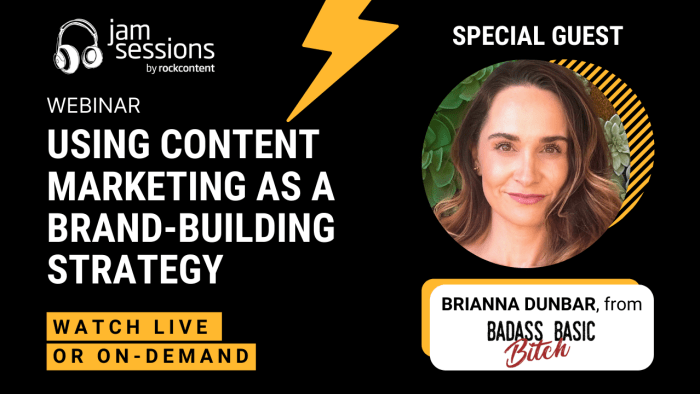Using Content Marketing for Brand Building dives into the art of crafting a brand’s identity through engaging content strategies, showcasing success stories, and enhancing consumer trust.
Explore the power of storytelling, influencer partnerships, and personalized content in this dynamic journey towards brand growth.
Importance of Content Marketing in Brand Building: Using Content Marketing For Brand Building
Content marketing plays a crucial role in establishing and strengthening a brand’s identity. By creating valuable and relevant content, brands can connect with their target audience on a deeper level, showcasing their values, personality, and expertise.
Examples of Successful Brands, Using Content Marketing for Brand Building
- Red Bull: Through their content marketing efforts like the Red Bull Stratos space jump live stream, Red Bull has successfully positioned itself as a brand associated with extreme sports and adventure.
- Dove: Dove’s “Real Beauty” campaign, focused on promoting body positivity and self-esteem, has resonated with consumers and helped build a strong emotional connection with the brand.
- GoPro: GoPro’s user-generated content strategy has not only showcased the capabilities of their products but also created a community of loyal brand advocates.
Creating Brand Loyalty and Trust
Content marketing plays a key role in creating brand loyalty and trust among consumers. By consistently delivering valuable and engaging content, brands can establish themselves as industry experts and build credibility. This, in turn, fosters trust among consumers, leading to long-term brand loyalty and repeat business.
Strategies for Using Content Marketing for Brand Building

Creating engaging content is key to enhancing brand visibility and awareness. By utilizing various content marketing strategies, brands can connect with their target audience on a deeper level and establish a strong brand presence in the market.
Storytelling
Storytelling is a powerful content marketing strategy that allows brands to communicate their message in a compelling and relatable way. By sharing stories that resonate with their audience, brands can create emotional connections and build brand loyalty.
Influencer Collaborations
Partnering with influencers who align with the brand’s values and target audience can help increase brand awareness and reach a wider demographic. Influencers can create authentic content that promotes the brand in a more personal and engaging manner.
User-Generated Content
Encouraging users to create and share content related to the brand can help generate buzz and increase brand credibility. User-generated content serves as social proof and can influence potential customers’ perceptions of the brand.
Aligning content marketing strategies with the brand’s overall objectives and values is crucial for success. It ensures that the content produced resonates with the target audience and reflects the brand’s identity accurately. By staying true to the brand’s core values, content marketing can effectively build brand equity and establish a strong brand presence in the competitive market.
Target Audience and Content Personalization

When it comes to brand building through content marketing, understanding your target audience is key. By knowing who your audience is, what they like, and what they need, you can create content that resonates with them on a personal level.
Personalized Content for Enhanced Brand Perception
Creating personalized content can significantly enhance brand perception among consumers. For example, if a skincare brand sends personalized recommendations based on a customer’s skin type and concerns, it shows that the brand cares about the individual’s needs. This, in turn, can build trust and loyalty.
- Personalized email campaigns addressing customers by their first name can create a sense of connection and exclusivity.
- Customized product recommendations on an e-commerce website can make the shopping experience more convenient and enjoyable for consumers.
- Tailoring social media content to different audience segments based on their interests and preferences can increase engagement and brand relevance.
Role of Data Analytics in Tailoring Content
Data analytics plays a crucial role in tailoring content to specific audience segments for effective brand building. By analyzing data such as demographics, behavior patterns, and interactions, brands can gain valuable insights into what content resonates with different audience groups.
Data analytics can help brands identify trends, preferences, and pain points among their target audience, allowing them to create content that addresses these specific needs.
- Utilizing A/B testing to determine which types of content perform best with different audience segments can help optimize brand messaging.
- Implementing marketing automation tools that use data to deliver personalized content at the right time and through the right channels can enhance brand engagement.
- Monitoring key performance indicators (KPIs) related to content engagement and conversion rates can provide valuable feedback for refining content strategies to better suit the target audience.
Distribution Channels for Content Marketing
In the world of content marketing, having a solid distribution strategy is crucial for maximizing brand reach and engagement. Let’s dive into various distribution channels and explore their advantages, disadvantages, and how to choose the best ones for your brand.
Social Media
Social media platforms like Facebook, Instagram, Twitter, and LinkedIn are powerful tools for distributing content to a wide audience. They allow for real-time interaction, sharing, and engagement with followers. However, the organic reach on social media has been declining, making it harder to reach your target audience without paid advertising.
Email Marketing
Email marketing remains a highly effective channel for distributing content directly to your audience’s inbox. It offers a more personalized approach and allows for segmentation based on user behavior. However, email fatigue is a real concern, and getting users to open and engage with your emails can be challenging.
(Search Engine Optimization)
focuses on optimizing your content to rank higher in search engine results pages (SERPs). By creating high-quality, relevant content that aligns with user intent and includes targeted s, you can attract organic traffic to your website. The downside is that is a long-term strategy that requires consistent effort and patience to see results.
Choosing the Right Distribution Channels
When deciding on distribution channels for your content marketing strategy, consider your brand’s target audience and goals. For example, if you’re targeting a younger demographic, platforms like Instagram and TikTok may be more effective. If your goal is to generate leads, email marketing could be a better choice. It’s essential to analyze the strengths and weaknesses of each channel and prioritize those that align best with your brand’s objectives.












